-
The BladeForums.com 2024 Traditional Knife is available! Price is $250 ea (shipped within CONUS).
Order here: https://www.bladeforums.com/help/2024-traditional/
You are using an out of date browser. It may not display this or other websites correctly.
You should upgrade or use an alternative browser.
You should upgrade or use an alternative browser.
Slice cutting telephone paper cross grain
- Thread starter postoak
- Start date
Wowbagger
Gold Member
- Joined
- Sep 20, 2015
- Messages
- 8,036
In the words of Pasquale Sciarappa : Oh Yeah BABY !
he's talking about his special hot peppers but applies here too.
My "Little Monster" could push cut phone book paper right off the kitchen knife rack. Hasn't been sharpened for a long time but he has superior geometry (big understatement there) and I am careful with the edge (plastic cutting boards only).
And my God Of Pocket Knives (for me anyway) the Para 2 in M4 . . . could not do it out of my pocket after a week of work . . . a little taste on the Spyderco Ultra Fine ceramic triangle stone . . . aaaaaannnnnnnnnd . . . we have push cutting phone book paper cross grain !
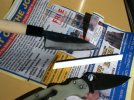
I never test my edges with paper. My test is just a little angular trip down my finger nail and I let it just catch a couple / several times along the edge. From this I have learned to tell the " good " to "Oh my gosh that's scary " state of an edge. When she sinks in in that sickening way I KNOW I'm there.
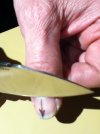
If I want to test my first test (calibrate my sensor for effectiveness) I try to cut a continuous curl off a finger nail like in the third photo. If I can do that I have a VERY EFFECTIVE and PRACTICAL edge sharpness for how I like to use my knives.
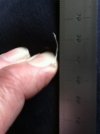
I tried to take one of those edges to phone book paper once but the paper ripped it's self loose from my hand, folded it's self into some origami horse like critter, then ran away and hid under the couch. Embarrassing for all concerned.
In case you like cooking vids and he's great even if you don't cook !
he's talking about his special hot peppers but applies here too.
My "Little Monster" could push cut phone book paper right off the kitchen knife rack. Hasn't been sharpened for a long time but he has superior geometry (big understatement there) and I am careful with the edge (plastic cutting boards only).
And my God Of Pocket Knives (for me anyway) the Para 2 in M4 . . . could not do it out of my pocket after a week of work . . . a little taste on the Spyderco Ultra Fine ceramic triangle stone . . . aaaaaannnnnnnnnd . . . we have push cutting phone book paper cross grain !

I never test my edges with paper. My test is just a little angular trip down my finger nail and I let it just catch a couple / several times along the edge. From this I have learned to tell the " good " to "Oh my gosh that's scary " state of an edge. When she sinks in in that sickening way I KNOW I'm there.

If I want to test my first test (calibrate my sensor for effectiveness) I try to cut a continuous curl off a finger nail like in the third photo. If I can do that I have a VERY EFFECTIVE and PRACTICAL edge sharpness for how I like to use my knives.

I tried to take one of those edges to phone book paper once but the paper ripped it's self loose from my hand, folded it's self into some origami horse like critter, then ran away and hid under the couch. Embarrassing for all concerned.
In case you like cooking vids and he's great even if you don't cook !
Last edited:
- Joined
- Jul 4, 2017
- Messages
- 2,007
With my traditional slipjoints (Case, Schrade USA, Buck, Vic, RR; i.e., no fancy steels) I have no trouble push cutting phone book paper with the grain, but going cross grain I have to slice, at least to get the cut started. Once it's well started sometimes I can manage a push cut.
- Joined
- Apr 12, 2009
- Messages
- 13,502
Most of the obstacles I see in cleanly cutting phonebook paper can usually be fixed or improved by thinning the edge geometry a little bit, or a lot, depending on how thick it's starting out. That fixes a lot of things, in fact.
And secondarily, a rolled burr or incomplete apex in portions of the edge where it hesitates or hangs up are a possibility as well. In my own uses, I see such issues back toward the heel of the edge more often, in addition to often having thicker edge geometry in the same portions. The heel of the blade often warrants extra attention, in sharpening. If you're attempting to start a cut at the heel of the blade, and it's hanging up there or slipping, I'd look at that portion first.
David
And secondarily, a rolled burr or incomplete apex in portions of the edge where it hesitates or hangs up are a possibility as well. In my own uses, I see such issues back toward the heel of the edge more often, in addition to often having thicker edge geometry in the same portions. The heel of the blade often warrants extra attention, in sharpening. If you're attempting to start a cut at the heel of the blade, and it's hanging up there or slipping, I'd look at that portion first.
David
For those who have knives that can do it, what angle are you putting on the blade? I'm doing a 30° primary and 40° micro-bevel. Are you going 30° all the way to edge, or even less? Although I would like to slice cut (and even better, push cut) cross-grain, I'm not willing to get away from a 40° edge just to do it.
- Joined
- Apr 12, 2009
- Messages
- 13,502
For those who have knives that can do it, what angle are you putting on the blade? I'm doing a 30° primary and 40° micro-bevel. Are you going 30° all the way to edge, or even less? Although I would like to slice cut (and even better, push cut) cross-grain, I'm not willing to get away from a 40° edge just to do it.
No higher than 30° inclusive, for me. Most of my knives are likely down in the ~25° range anyway; they all end up around that figure, by the time I have them cutting the way I want them to. I don't apply a microbevel at all. If you do still want to use a microbevel, thinning the primary to ~25° and doing the micro at 30° could still work pretty well, I'd think.
I've never much liked paper-cutting performance of any edge, microbevelled or not, at 40° or higher. Improvement comes somewhere below 35° at least, and even better around 30° and lower. Basic utility uses do OK at 40°; but, I've never seen finer cutting tasks, such as in paper or in shaving-sharpness tests, do very well at 40°. The apex has to be perfect, if it's going to do well. When the apex loses it's perfect crispness at 40° or higher, cutting performance really takes a big dive.
David
That's good to know. The knives I care most about are my hunting knives and I won't go below 40° on them. It's nice to know I'm not doing any wrong -- I just won't be able to pass these extreme paper tests I like to attempt after sharpening -- with the angle I like to use. Realistically, my test for adequate sharpness is slice cutting down the page which is easy to achieve.
Last edited:
Wowbagger
Gold Member
- Joined
- Sep 20, 2015
- Messages
- 8,036
For those who have knives that can do it, what angle are you putting on the blade? I'm doing a 30° primary and 40° micro-bevel. Are you going 30° all the way to edge, or even less? Although I would like to slice cut (and even better, push cut) cross-grain, I'm not willing to get away from a 40° edge just to do it.
I totally agree with Obsessed with Edges.
No higher than 30° inclusive, for me. Most of my knives are likely down in the ~25° range anyway; they all end up around that figure, by the time I have them cutting the way I want them to. I don't apply a microbevel at all. If you do still want to use a microbevel, thinning the primary to ~25° and doing the micro at 30° could still work pretty well, I'd think.
I've never much liked paper-cutting performance of any edge, microbevelled or not, at 40° or higher. Improvement comes somewhere below 35° at least, and even better around 30° and lower. Basic utility uses do OK at 40°; but, I've never seen finer cutting tasks, such as in paper or in shaving-sharpness tests, do very well at 40°. The apex has to be perfect, if it's going to do well. When the apex loses it's perfect crispness at 40° or higher, cutting performance really takes a big dive.
This deserves repeating about three times :
repeatThe apex has to be perfect, if it's going to do well. When the apex loses it's perfect crispness at 40° or higher, cutting performance really takes a big dive
repeat
That's part of my obsession and respect for guided sharpening equipment i.e. Edge Pro Apex
Yes I sharpen by hand and get whittling results
but
I have had edges off a guided system . . . super consistently . . . brainlessly easy and hair whittling at 50° inclusive and wider. Just frightening sharpness and very robust geometry.
Why would you want that ? ? ? ? I hear people hollering
For hand tool woodworking of really tearout prone wood grain in really hard or highly figured grain that goes every which way and has hard spots in it (little knots ).
In some cases say 45° or 47° won't cut it (pun intended) but say 54° or so will without damaging the edge of the tool and without chipping out little divots out of the surface of the wood.
This would be for the final surfacing of the wood before putting on the finish (no sand paper).
This kind of edge produces a bare wood surface that is not only flawless but even reflective.
Hard to believe but true. And to those in the know : not burnished wood but actually CUT that way.
I have no use for pocket knife edges this robust and again agree with Obsessed's geometry for pocket knives. Even thinner shallower for my kitchen knives.
Two examples of bare wood, freshly cut reflecting light
these are really old photos taken for other purposes but I keep them around for such discussions.
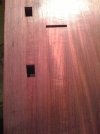
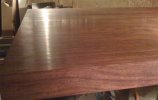
For comparison here is the same table with the finish on it.
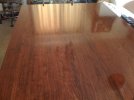
Here you can see the sharpening edge angles written on the blades in magic marker
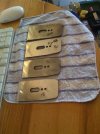
- Joined
- Dec 7, 2016
- Messages
- 11,261
For those who have knives that can do it, what angle are you putting on the blade? I'm doing a 30° primary and 40° micro-bevel. Are you going 30° all the way to edge, or even less? Although I would like to slice cut (and even better, push cut) cross-grain, I'm not willing to get away from a 40° edge just to do it.
Judging by the angles you stated I assume you are usingnthe Spyderco Sharpmaker. Just keep practicing and you will get it. I use my sharpmaker rods freehand (knife in one hand rod in other) because I found it difficult to get my knives sharp using the sharpmaker jig that sets the rods in that V shape. That is because most knives do not come exactly at 30 degrees inclusive. The Sharpmaker is also not good at resetting the bevels to those angles.
That said as you sound new to sharpening I don't want you to be discouraged. You can get most knives plenty sharp with the sharpmaker. You are probably putting too much pressure on the stones as you do your stokes. Pressure does not cut the steel, the abrasives do. More pressure only results in a burr. As you do your microbevel be very gentle on the pressure. The microbevel (40 degree setting) will likely be the angle that is hitting the apex of your edge so be especially gentle with the pressure here. Not too too many stokes here either. Do a few and test the edge on printer paper.
Even if you are not using the sharpmaker the rules about light pressure still apply.
Also what steel are you trying to sharpen and which stones (or rods) are you using.
P.S. This knife eats phonebook paper forwards backwards and sideways. I still am not pro enough to slice Bounty Paper Towel.

No, I'm not new to sharpening. I have a Sharpmaker and a 1 x 30 bench sander. I've tried so many other systems since I started sharpening as a teen I'd have a sizeable chunk of change if I could get back all the money I spent on them. Some, I did sell and recoup some of my money.
With the Sharpmaker I can kinda sorta get push-cutting down the page, which is way sharper than I need, but not the holy grail of cross-grain cutting. At 40°, it seems, that's the best I'll do. I have tons of experience with the Sharpmaker and have the diamond and super-fine rods to complement the base system.
With the Sharpmaker I can kinda sorta get push-cutting down the page, which is way sharper than I need, but not the holy grail of cross-grain cutting. At 40°, it seems, that's the best I'll do. I have tons of experience with the Sharpmaker and have the diamond and super-fine rods to complement the base system.
With the Sharpmaker I can kinda sorta get push-cutting down the page, which is way sharper than I need, but not the holy grail of cross-grain cutting. At 40°, it seems, that's the best I'll do. I have tons of experience with the Sharpmaker and have the diamond and super-fine rods to complement the base system.
Sounds like you are using reasonable angles on a hunting knife for your secondary bevel (15 dps) and micro-bevel (20 dps), and if you can get that knife sharp enough to push-cut with the grain, I'm not sure you need more than that for a hunting knife. I get that you want to do better, I do with my knives too, it's just fun.
If you're interested in getting this done with Sharpmaker, I think it's achievable. I've seen people getting this even with the diamond rods, but I found it easier with the SiC stones. Using my Congress Tools Sic stones, I reprofiled my Kershaw Link M390 to 15 dps, then put a 20 dps micro bevel, and it would push-cut newsprint cross-grain, slice off chunks of thin receipt paper, and slice thru paper towel (pictured).
How I did this with Sharpmaker:
- Profile to 15 dps: About 50 passes per site on 240 grit SiC stone. Then about 30 per side on 600 grit SiC.
- Micro-bevel to 20 dps: 10 passes per side on the corners of the Spyderco UF rods.
- Strop: 10 passes per side on basswood block with 1 micron Gritomatic CBN compound.
- Total time: 35 minutes
ETA, here a new-ish Buck Vantage Pro in S30v, also sharpened using Sharpmaker, that can cleanly cross-cut thin catalog newsprint paper:
Last edited:
- Joined
- Dec 7, 2016
- Messages
- 11,261
No, I'm not new to sharpening. I have a Sharpmaker and a 1 x 30 bench sander. I've tried so many other systems since I started sharpening as a teen I'd have a sizeable chunk of change if I could get back all the money I spent on them. Some, I did sell and recoup some of my money.
With the Sharpmaker I can kinda sorta get push-cutting down the page, which is way sharper than I need, but not the holy grail of cross-grain cutting. At 40°, it seems, that's the best I'll do. I have tons of experience with the Sharpmaker and have the diamond and super-fine rods to complement the base system.
Sorry I hope I didn't offend you. I made an assumption and I made an ass out of me. (Close enough to the saying)
It seems I was right in my guess that you are hsing the sharpmaker though. If you have experience sharpening then that is great. Try turning the closed black sharpmaker plastic "box" upside down. There are two slots in the bottom to accept two sharpmaker rods. Now you can use the stones freehand.
I'm sure you probably already know this so give it a shot that way you can match the angle to what is actually on the knife more easily.
- Joined
- Sep 23, 2014
- Messages
- 1,287
Hi,No, I'm not new to sharpening. I have a Sharpmaker and a 1 x 30 bench sander. I've tried so many other systems since I started sharpening as a teen I'd have a sizeable chunk of change if I could get back all the money I spent on them. Some, I did sell and recoup some of my money.
With the Sharpmaker I can kinda sorta get push-cutting down the page, which is way sharper than I need, but not the holy grail of cross-grain cutting. At 40°, it seems, that's the best I'll do. I have tons of experience with the Sharpmaker and have the diamond and super-fine rods to complement the base system.
How are you holding the paper?
What exactly are you doing with the sharpmaker?
I couldn't push cut printer paper
with a brand new utility razor
cause I couldn't keep the paper and blade vertical and not-slicing,
I still can't exactly push cut with the blade tip up 45 degrees ,
I always slice in that position.
took me some time to learn
to lean blade against the fingers holding the paper
and then push down without any slicing motion
Speaking of sharpmaker,
it should be possibly to get push cutting at 20dps,
although you might have to change how you're using the sharpmaker.
How are you deburring, are you double angle deburring?
Try this,
using ultra light passes (under 100 grams )
eyeball a 40 degree per side angle
by tilting away from sharpmaker stones
to double the available sharpmaker setting,
and do 1-2 light (under 100 grams) alternating passes per side
on the flats of the brown medium grit rods,
check for burr, and do another 1-2 alternating pps if needed,
then back to your original finishing angle for 5 alternating passes on brown rods,
then another 5 ultra light alternating passes on white triangles
then stop and push cut some phonebook paper
For more detailed/advanced sharpmaker debugging steps see Sharpening Curriculum / Trouble sharpening super blue - Spyderco Forums
